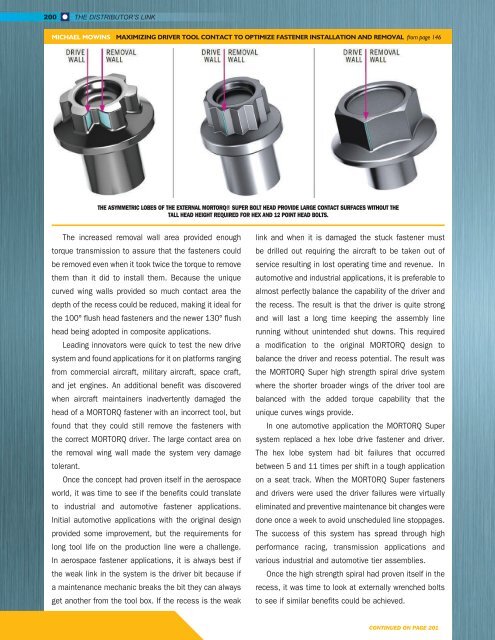FALL 2017
Distributor's Link Magazine Fall Issue 2017 / Vol 40 No4
Distributor's Link Magazine Fall Issue 2017 / Vol 40 No4
You also want an ePaper? Increase the reach of your titles
YUMPU automatically turns print PDFs into web optimized ePapers that Google loves.
200<br />
THE DISTRIBUTOR’S LINK<br />
MICHAEL MOWINS MAXIMIZING DRIVER TOOL CONTACT TO OPTIMIZE FASTENER INSTALLATION AND REMOVAL from page 146<br />
THE ASYMMETRIC LOBES OF THE EXTERNAL MORTORQ® SUPER BOLT HEAD PROVIDE LARGE CONTACT SURFACES WITHOUT THE<br />
TALL HEAD HEIGHT REQUIRED FOR HEX AND 12 POINT HEAD BOLTS.<br />
The increased removal wall area provided enough<br />
torque transmission to assure that the fasteners could<br />
be removed even when it took twice the torque to remove<br />
them than it did to install them. Because the unique<br />
curved wing walls provided so much contact area the<br />
depth of the recess could be reduced, making it ideal for<br />
the 100° flush head fasteners and the newer 130° flush<br />
head being adopted in composite applications.<br />
Leading innovators were quick to test the new drive<br />
system and found applications for it on platforms ranging<br />
from commercial aircraft, military aircraft, space craft,<br />
and jet engines. An additional benefit was discovered<br />
when aircraft maintainers inadvertently damaged the<br />
head of a MORTORQ fastener with an incorrect tool, but<br />
found that they could still remove the fasteners with<br />
the correct MORTORQ driver. The large contact area on<br />
the removal wing wall made the system very damage<br />
tolerant.<br />
Once the concept had proven itself in the aerospace<br />
world, it was time to see if the benefits could translate<br />
to industrial and automotive fastener applications.<br />
Initial automotive applications with the original design<br />
provided some improvement, but the requirements for<br />
long tool life on the production line were a challenge.<br />
In aerospace fastener applications, it is always best if<br />
the weak link in the system is the driver bit because if<br />
a maintenance mechanic breaks the bit they can always<br />
get another from the tool box. If the recess is the weak<br />
link and when it is damaged the stuck fastener must<br />
be drilled out requiring the aircraft to be taken out of<br />
service resulting in lost operating time and revenue. In<br />
automotive and industrial applications, it is preferable to<br />
almost perfectly balance the capability of the driver and<br />
the recess. The result is that the driver is quite strong<br />
and will last a long time keeping the assembly line<br />
running without unintended shut downs. This required<br />
a modification to the original MORTORQ design to<br />
balance the driver and recess potential. The result was<br />
the MORTORQ Super high strength spiral drive system<br />
where the shorter broader wings of the driver tool are<br />
balanced with the added torque capability that the<br />
unique curves wings provide.<br />
In one automotive application the MORTORQ Super<br />
system replaced a hex lobe drive fastener and driver.<br />
The hex lobe system had bit failures that occurred<br />
between 5 and 11 times per shift in a tough application<br />
on a seat track. When the MORTORQ Super fasteners<br />
and drivers were used the driver failures were virtually<br />
eliminated and preventive maintenance bit changes were<br />
done once a week to avoid unscheduled line stoppages.<br />
The success of this system has spread through high<br />
performance racing, transmission applications and<br />
various industrial and automotive tier assemblies.<br />
Once the high strength spiral had proven itself in the<br />
recess, it was time to look at externally wrenched bolts<br />
to see if similar benefits could be achieved.<br />
CONTINUED ON PAGE 201

















